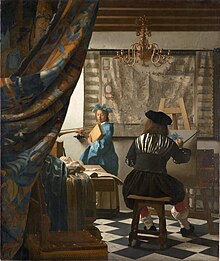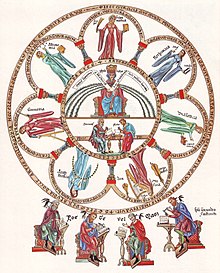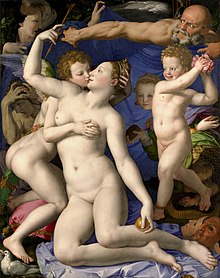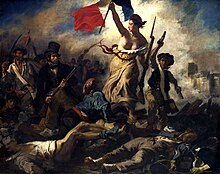allegory

The allegory ( ancient Greek ἀλληγορία allegoría 'other' or 'veiled language'; from ἄλλος állos 'different', 'different', 'in another way' and ἀγορεύω agoreúo 'to speak emphatically', 'to make a public statement', to ἀγορά agora 'Assembly') is a form of indirect statement in which one thing (thing, person, process) is used as a sign of another thing (thing, person, process, abstract concept) due to similarities or relationships .
In rhetoric , the allegory is classified as a stylistic figure under the tropics (forms of improper speech) and is there as continuous, i.e. H. Metaphor that goes beyond a single word . In the fine arts and in large parts of medieval and baroque literature , allegory occurs particularly in the special form of personification , in which a person is represented by attributes , actions and speech as an illustration of an abstract concept, e.g. B. a virtue or a vice, acts.
Under allegory ( allegorical interpretation ) is the interpretation of allegories of any kind, such as one speaks of letters, gemstone, color, clothes and Blumenallegorese. In literary studies , allegory describes the historical interpretation of a text according to a meaning that goes beyond the literal meaning.
In mathematical category theory , an allegory after Freyd and Sceodrov is the category of two-place relations between different sets (in contrast to the relational algebra of homogeneous two-place relations).
Basics
On function and meaning
In the interpretation of mythological and sacred texts, the assumption of allegories has played a special role in the concern of interpreting the traditional text, which in its literal statement has become partially implausible or incomprehensible, to a hidden wisdom or truth and thus to the thinking and belief of one's own time and to show culture as anticipated and certified in the past.
As a linguistic or artistic expression, an allegory is constructed from the outset with a view to its interpretation . The allegory requires the listener or viewer to make a thought leap ( association = a conscious or unconscious connection of thoughts) from what is said or figuratively represented to the intended meaning. If the viewer is not familiar with the spiritual or historical context from which the allegory was constructed, its meaning is often hidden from him. Realistic allegories - with them the literal or immediate meaning in itself has an instructive or entertaining effect - often overlook the fact that there are further (going) allegorical intentions.
Allegory and symbol
Attempts to delimit allegory and symbol from one another since the 18th century are often characterized by philosophical profundity, but are not very consistent in terms of literary and symbol theory and, when applied to ancient , medieval and baroque allegories, lead to historical shortenings. A symbol is sometimes understood as a sign that expresses the said thing for its own sake and its peculiarity, and not only for the sake of the generalizability of the transferred statement, also merely indicates its deeper meaning, but defines it less than allegory, and therefore ultimately to be understood more intuitively than to be deciphered intellectually. Above all, what is represented should still be present in the symbol, whereby an inner and outer unity of signs and meaning is preserved.
Allegory lacks this unity, it is broken and is in tension with the idea behind it. Aesthetically, during classicism , the symbol, perceived as more poetic, was usually given preference over the rationally sober allegory, which was underestimated as a thought game, which was underestimated as the inferior or even unpoetic form of expression in the context of a literary and art conception oriented towards immediacy, feeling and individuality. Through Walter Benjamin , allegory was upgraded in the modern age : "The symbol is the identity of the particular and the general, the allegory marks their difference ." As an art form against idealistic aesthetics, it became paradigmatic for modernity.
Historical development and examples
In ancient Greece, numerous forces and conditions were deified if they were permanent. The Greek heaven of gods was therefore so diverse that allegory was seldom needed. As far as is known, however, the Greek painters used personified abstracts for internal processes and conditions such as outrage or envy, which they were not yet able to represent through facial expressions or gestures, and placed them next to the acting figures to show their motifs. This changed in the Hellenistic and Roman times: the deity was increasingly replaced by allegory. Not only natural processes were now allegorized, but also state and political conditions.
The use of allegory reached an early high point in the fine arts of the early Renaissance , in which abstracts and spiritual qualities were personified. For a better understanding, allegories often had to be provided with inscriptions or attributes (e.g. cowardice was represented by a man fleeing from a rabbit). Since the High Middle Ages, allegory has often served moral and theological purposes, e.g. B. to represent virtues and sins. Medieval church painting , sculpture ( Strasbourg Cathedral ) and goldsmithing ( Verdun Altar in Klosterneuburg ) and baroque painting (e.g. Rubens ) made ample use of instructive allegory and created numerous figures representing good or evil.
Since the French Revolution , allegories have also embodied political ideas such as freedom or popular sovereignty.
Since the middle of the 19th century - under the influence of the gable figures of the Parthenon exhibited in London , the so-called Elgin Marbles - more and more sculptural allegories (often female figures) were used as decorative or supporting figures to indicate the purpose and purpose of public buildings (previously, for example, at the Panthéon in Paris ).
The allegory can also be used as a pictorial personification of a state. In the form of a Nationalallegorie be found for example for the German Reich , the Germania , for Austria, Austria , to Prussia Borussia, for Switzerland , the Helvetia , for France the Marianne , for the UK the Britannia or the United States , the Lady Liberty or Uncle Sam .
- The death as a skeleton (the meat passes) and with the sense (he takes all).
- The justice as a woman ( Justitia ; iustitia is in Latin female) blindfolded (without discrimination), in one hand a pair of scales (just speculatively) (judging) and in the other a sword.
- Albrecht Dürer's Melencolia I can, contrary to the prevailing interpretation as melancholy, be understood as an allegory of consolation through meditation (see: Jacob's ladder of prayer with seven rungs - see also: Melencolia's pi-theta belt corresponding to the hems of the dress of Philosophia in Boetius 'Consolation of Philosophy, 524) as well as the sciences ( quadrivium : arithmetic, geometry, astronomy & music) as well as Dürer's artistic creativity and art theory .
Since the allegory is an indirect sign of what is represented, it is not understood directly, but only through abstraction - or convention .
Linguistic allegory
Allegory in Literature
The following are known in literature: allegory and allegory , forms that explain the content of texts, with allegory being the form of interpretation and allegory being the form of text. The hermeneutic method of an allegorical interpretation of texts was first used in antiquity for the interpretation of Homer's epics and Hesiod's theogony . The various schools of philosophy attempted not only to understand the texts literally, but to discover a hidden meaning in them. The stories of the gods of the pre-classical period, which were perceived as scandalous in classical times, such as those handed down by Homer or Hesiod, could be justified in this way.
In Rome, the allegorical interpretation of myths of gods practiced by the Greeks was adopted. Allegorical figures were u. a. Invented by Lukan ( Roma ), Virgil ( Fama ), Lucretius and Ovid . Boethius ' book Consolations of Philosophy comes from the late Roman period , in which, in addition to the muses of poetry, philosophy as a person speaks to the author. Far-reaching influence on medieval literature and art was Prudentius ' Psychomachia from the 4th century AD, an allegorical portrayal of the struggle between Christian virtues and pagan vices .
By the end of the Middle Ages , numerous fantastic allegorical works were created, such as the Anticlaudian of Alanus from Insulis in the 12th century, who in the foreword to his book expressly forbade reading the text literally, or the extremely popular and widespread rose novel by Guillaume de Lorris and Jean de Meung . The Bible also appeared in allegorical form, for example in the high medieval Eupolemius , in which the history of salvation from the fall of man to the resurrection of Christ is retold. In the transition period between the Middle Ages and the Renaissance , Petrarch wrote his De remediis utriusque fortunae , an allegorical guide for people about how to deal with happiness and unhappiness, and finally Dante 's Divine Comedy, which has been handed down in many illustrated manuscripts .
In the Baroque era , allegories flourished in all areas of literature, be it in poems, speeches of all kinds, sermons, grave inscriptions, etc. They still appear today in the play of the suffering of Christ and in the passion procession .
Allegory in the Bible
With regard to the Bible, there are two main directions of allegory, as a form of interpretation to explain the contents of the respective holy scriptures, for Christianity the Christian Bible , for Judaism mainly Torah , Hebrew Bible , Talmud , Responses and Rabbinic literature .
Judaism
With the Pardes classification, Judaism knows four different approaches for the exegesis of the Jewish Bible, the Tanakh and the sacred texts in the tradition of rabbinic Judaism . PaRDeS is an acronym for the classic Jewish interpretation of texts when studying the Torah .
With the help of this system, passages from the Bible can be interpreted over and over again in a new, non-literal sense. An example of this is Leviticus 20:10 EU , where death is required for adulterers and adulteress. In liberal Judaism in particular , this demand is interpreted allegorically today. Adultery can be understood here as turning away from God as the source of all life. Under Drasch personal views on the meaning of marriage are conceivable, and the last level Sod can be understood as a mystical bond between man and God.
The allegorical interpretation of the Torah was used extensively in ancient times by Philo of Alexandria .
Christianity
In the Christian tradition, the idea of the multiple biblical sense of writing has developed, according to which the biblical text has on the one hand a historically true or literal meaning that can be classified as fictional ( parable ) ( sensus litteralis ) and, on the other hand, in multiple levels of meaning to historically posterior ( typological sense), moral ( tropological sense) or eschatological ( anagogical sense) things are to be interpreted.
Allegory was also practiced for the Christian Bible from an early age . The apostle Paul interprets Hagar and Sarah as the old and the new covenant ( Gal 4,21–31 LUT ). Origen relates the Song of Songs of the Old Testament to the love between Christ and the soul of the believer. Augustine shaped Christian allegory beyond the Middle Ages . For the allegorical interpretation of the Holy Scriptures, he required the interpreter to have knowledge of grammar , rhetoric , linguistics as well as extensive knowledge of the things of nature , of numbers and music, but not of pagan myths and pagan mantic or astrology .
Luther did not appreciate allegorical interpretations of Bible texts and made fun of Origen. On the other hand he used allegories in his after-dinner speeches and sermons, as they do not "rational knowledge of the happened historically, although the listener mystery enabled, but his face-off ( allusio ) and natural affection of."
Allegory in Rhetoric
In rhetoric , allegory is a technical term. The linguistic form of the allegory is understood in rhetoric as a rhetorical trope . Like all tropics, it requires a leap of thought from what is said to what is meant. Through the semantic forms similitudo (comparison) and contrarium (opposite) it is related to the metaphor , the exemplum (example), the aenigma (riddle), the proverbium ( proverb ), irony , euphemism , etc. In rhetoric it can can be used in many ways, for example in praise and praise speeches, for arguing, for teaching, for satires, jokes and the like.
In his book De oratore, Cicero attributed various possible uses to the allegory: it served to clarify the subject of the speech or to hide it, the brevity of the presentation and the entertainment of the audience. In his book on rhetoric De institutione oratoria , which was authoritative into the Middle Ages , Quintilian provided a rhetorical theory of allegory.
Pictorial allegory
Since allegory depicts abstract facts through images, it is a possibility, especially in the fine arts , to make conventions clear in images, and thus a possibility to interpret these images. It is therefore also a way of making abstract facts clearer and therefore easier to understand.
Antiquity
Allegorical representations have been common in the fine arts since ancient times. In ancient Greece, allegories can be found, among other things, as marble reliefs on altars and on the pediments of temples, or as a surrounding frieze there. Significant diverse representations of allegorical scenes can also be found on the vase paintings in Hellas .
In Roman art, allegory is a common form of representation on gems , coins , sarcophagi or triumphal arches . Personifications of abstract ideas and conceptions - such as "happiness", "peace", "unity", "seasons", "money" or certain cities or states - were used for the pictorial memory of a certain person on sarcophagi, for the glorification of certain historical events Triumphal arches or to illustrate religious or cosmological ideas.
Famous is the lost painting The Defamation of the Painter Apelles with its parade of allegorical figures such as rumor , envy or the naked truth , which was recreated in the Renaissance as a painting by Sandro Botticelli with the title The Defamation of Apelles, based on an Ekphrasis by Lucian of Samosata , as well as the relief of the Cairo , an allegory of the favorable opportunity , by the Hellenistic sculptor Lysipp, preserved only in a Roman copy .
middle Ages

Ancient allegorical pictorial formulas were also used and reinterpreted in early Christian art. Of particular importance for the production of allegorical pictures in Christian art are the theses of Isidore of Seville on the use of allegorical texts, which in the course of the picture dispute were also used as arguments for the picture in the context of Christian religion. In the course of the Middle Ages, new allegories developed in connection with Christian dogmatics , which appear in countless variations in painting, sculpture and even architecture. Typical examples are the four cardinal virtues , the seven deadly sins , the seven liberal arts , woman world, Ecclesia and synagogue and number allegories.
One of its own expressions of allegorical interpretation of texts, which is reflected in the visual arts, is the classification , in which the events of the Old and New Testaments were linked to one another as type and antitype . The individual text passages of the Bible or their pictorial representation could be subjected to different modes of interpretation, in which the literal ( sensus litteralis ) and the spiritual ( sensus spiritualis ) meaning had to be distinguished. The allegorical meaning ( sensus allegoricus ), the moral meaning ( sensus tropologicus ) and the eschatological meaning ( sensus anagogicus ) had to be taken into account .
Renaissance and Baroque
The allegories received new impulses from the growing interest of humanistic scholars in Neoplatonism . All appearances in the world can be seen as images of divine beauty. For example, ideas of Neoplatonic scholars at the Medici court in Florence were reflected in Botticelli's pictures .
Even pagan sources can be "mirror of divine beauty and wisdom." An example of the reassessment of non-Christian sources is the interest in Egyptian hieroglyphs , such as the Horapollon hieroglyphic script discovered in 1419 . In 1499 the allegorical novel Hypnerotomachia Poliphili by Francesco Colonna was published , which opened the play of the artists and poets of the Renaissance and Baroque with the emblematic . Andrea Alciato's Emblematum liber of 1531 saw many editions and subsequently served artists such as the Iconologia des Cesare Ripa , 1593, as a generally recognized and widely used book for allegorical representations. In addition to the allegories known from the Middle Ages, new ones such as B. Hercules as the embodiment of the virtuous man or the perfect ruler.
The tendency towards the dark and incomprehensible in allegories, which Cicero had already noticed, increased in the Renaissance, as exemplified in the pictures for Isabella d'Estes studiolo , and is evident in mannerist pictures that are difficult to interpret, such as the allegory of love of the Bronzino .
Allegorical painting flourished in the course of the Counter-Reformation in the painting of Catholic churches and at the same time in the design of baroque palace and park facilities.
Romanticism and Classicism to the present day
In the following time, the desire for allegory declined among artists and clients. Allegory was increasingly said to have dry and low-feeling constructions of thought. Art theorists of the 18th century such as Gotthold Ephraim Lessing , Moses Mendelssohn and later also Edgar Allan Poe questioned the meaning of allegorical representations, while Johann Joachim Winckelmann , Johann Wolfgang Goethe and above all Nathaniel Hawthorne - one of the most famous allegorical writers in world literature - took allegory more positively faced. Nevertheless, there were still allegorical paintings such as the Allegory of Freedom by Eugène Delacroix or the times of day pictures by Philipp Otto Runge . During the Wilhelminian era , allegorical sculptures played an important role in the decoration of representative buildings or monuments such as the German Reichstag or the Niederwald monument near Bingen am Rhein .
Even 20th century artists such as B. Max Beckmann , occasionally work with allegorical representations.
Examples

- Lysipp : Kairos , Roman copy, Turin, Museum of Antiquities
- Ekklesia and Synagogue , around 1225–1235, Strasbourg Cathedral, Musée de l'Œuvre Notre-Dame , Strasburg
- Lorenzetti : The good government; the bad government, 1338–1339, Siena, Palazzo Pubblico
- Botticelli : Primavera , Florence Uffizi Gallery , around 1482
- Botticelli: The Defamation of Apelles , around 1490/95, Florence, Uffizi
- Bronzino : Allegory of Love , around 1545, National Gallery (London)
- Bronzino: Andrea Doria as Neptune , 1540–1550, Milan, Pinacoteca di Brera
- Sacred Allegory , painting by Giovanni Bellini, Florence, Uffizi
- Rubens : Allegory of War and Peace, National Gallery (London)
- Luca Giordano : Triumph of the Medici in the clouds of Olympus, Palazzo Medici Riccardi , Florence
- Giovanni Battista Tiepolo : Allegory of the four continents, ceiling frescoes in the stairwell of the Würzburg Residence , 1752–53, Würzburg
- Asmus Carstens : The night and its children sleep and death, 1795, Weimar, Staatliche Kunstsammlungen
- Delacroix : Freedom leads the people or July 28, 1830, 1830, Paris, Louvre
- Gustav Klimt : Roman and Venetian Quattrocento , 1891, Vienna, Kunsthistorisches Museum
- Renoir ; The Rhône welcomes the Saône, [1901], Paris, Galerie Durand-Ruel
- Max Beckmann : The Night, Düsseldorf Art Collection North Rhine-Westphalia
- In 2005, the Deutsche Guggenheim exhibition in Berlin showed works by Duchamp , Damien Hirst , Jeff Koons , Man Ray , Andy Warhol and the film directors Bernardo Bertolucci , Francis Ford Coppola , Walt Disney , and others under the title Douglas Gordon 's The Vanity of Allegory . Federico Fellini , Jean-Luc Godard , Stanley Kubrick , Pier Paolo Pasolini , Andrei Tarkovsky and Luchino Visconti .
Quote
“Allegory transforms the appearance into a concept, the concept into a picture, but in such a way that the concept is still limited and complete in the picture, to be had and to be expressed in the same.
The symbolism transforms the appearance into an idea, the idea into a picture, and in such a way that the idea in the picture always remains infinite and, even when pronounced in all languages, remains inexpressible. "
See also
literature
- Gerhard Kurz: metaphor, allegory, symbol . Small Vandenhoeck series 4032. Vandenhoeck & Ruprecht, Göttingen 6th edition 2009, ISBN 3-525-34032-X (standard work)
- Reinhart Hahn: The Allegory in Ancient Rhetoric. Tübingen 1967.
- Walter Benjamin : Origin of the German tragedy ; 1928
- Heinz Meyer: On the relationship between encyclopedia and allegory in the Middle Ages . In: Early Medieval Studies 24. 1990. pp. 290-313
- Rudolf Wittkower : Allegory and the change of symbols in antiquity and renaissance . Cologne 1984.
- Cäcilia Rentmeister : Professional ban for the muses. Why are so many allegories female? In: Aesthetics and Communication, No. 25/1976, pp. 92–112. Long version in: Women and Science. Contributions to the Berlin Summer University for Women, July 1976, Berlin 1977, pp. 258–297. Cillie Rentmeister Art History Allegory Sphinx Oedipus | Cillie (Cäcilia) Rentmeister: Publications
- Meinolf Schumacher : Introduction to the German literature of the Middle Ages. Scientific Book Society, Darmstadt 2010; Pp. 35–42: “God and Nature: Hermeneutics of Scripture and Nature”.
- Heinz J. Drügh: Different speech. On the structure and historical systematics of the allegorical. Freiburg 2000.
- Alfred Meurer: Industry and technology legories of the imperial era, iconography and typology. Publishing house and database for the humanities (VDG), Weimar 2014. ISBN 978-3-89739-808-5
- Wolfgang Harms , Heimo Reinitzer (ed.): Natural history and allegorical interpretation of nature. Aspects of the world view between the 13th and 19th centuries. Bern / Frankfurt am Main 1980 (= Mikrokosmos. Volume 7).
Web links
Individual evidence
- ↑ Duden .
- ↑ Tilo Brandes: 'From the letters'. In: Burghart Wachinger et al. (Hrsg.): The German literature of the Middle Ages. Author Lexicon . 2nd, completely revised edition, volume 1 ( 'A solis ortus cardine' - Colmar Dominican chronicler ). De Gruyter, Berlin / New York 1978, ISBN 3-11-007264-5 , Sp. 1111.
- ↑ Yohji Akama, Yasuo Kawahara, Hitoshi Furusawa: Constructing Allegory from Relation Algebra and Representation Theorems. ( Memento of July 13, 1998 on the Internet Archive ), University of Tokyo
- ^ Peter J. Freyd, André Scedrov: Categories, Allegories, North-Holland Mathematical Library, Vol. 39, North-Holland, 1990
- ^ Walter Benjamin : Collected writings. Suhrkamp, Frankfurt am Main 1987, vol. 1, p. 352.
- ↑ Jacob Burckardt: The Allegory in the Arts. (1897) In: Ders .: Cultural history lectures. Edited by Rudolf Marx, Stuttgart 1959, p. 322 ff., 333 ff.
- ↑ Meditation is to knock on the stone (for water of life) with Moses "Meditari est pulsare cum Mose hanc petram" (Luther WA 3rd vol. 1885, 21)
- ^ Daniel Lanzinger: An "unbearable philological antics"? Pauline use of script in the context of ancient allegory . Vandenhoeck & Ruprecht, Göttingen 2016, ISBN 978-3-525-59370-7 .
- ↑ Augustine's allegorical interpretation of the parable of the Good Samaritan can be found here: http://www.uni-due.de/Ev-Theologie/courses/course-stuff/allegorese-lk10.htm , read on May 1, 2009.
- ↑ Historical dictionary of rhetoric . Volume 1, p. 359.
- ↑ J. Dominik Harjung: Encyclopedia of Language Arts. C. H. Beck, Munich 2000.



